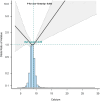U-shaped association between serum calcium and in-hospital mortality in diabetes patients with congestive heart failure: a cohort study
- PMID: 38862553
- PMCID: PMC11167038
- DOI: 10.1038/s41598-024-63603-w
U-shaped association between serum calcium and in-hospital mortality in diabetes patients with congestive heart failure: a cohort study
Abstract
Previous studies have reported that the significant association between serum calcium and mortality substantially in patients, especially among those with intensive care unit (ICU). And In diabetes mellitus, congestive heart failure (CHF) is a significant comorbidity. We aim to evaluate the association between serum calcium levels and in-hospital mortality among patients with diabetes and congestive heart failure. The participants in this study were extracted from the Medical Information Mart for Intensive Care IV (MIMIC-IV) database. To scrutinize potential associations between serum calcium levels and in-hospital mortality, a comprehensive analysis encompassing multivariate logistic regression, cubic spline function model, threshold effect analysis, and subgroup analysis was performed. This retrospective cohort study encompassed 7063 patients, among whom the in-hospital mortality stood at 12.2%. In the multivariate logistic regression, adjusted odds ratios (ORs) were contrasted with the reference category Q6 (8.8-9.1 mg/dL) for serum calcium levels and in-hospital mortality. The adjusted ORs for Q1 (≤ 7.7 mg/dL), Q2 (7.7-8 mg/dL), and Q7 (≥ 9.1 mg/dL) were 1.69 (95% CI 1.17-2.44, p = 0.005), 1.62 (95% CI 1.11-2.36, p = 0.013), and 1.57 (95% CI 1.1-2.24, p = 0.012) respectively. The dose-response analysis uncovered a U-shaped relationship between serum calcium levels and in-hospital mortality in diabetic patients with heart failure. Subgroup analyses confirmed result stability notwithstanding the influence of diverse factors. Our investigation revealed a U-shaped correlation between serum calcium levels and in-hospital mortality in diabetes patients with congestive heart failure, pinpointing a significant inflection point at 9.05 mg/dL.
Keywords: Association; Blood calcium; Cubic spline function model; Diabetes; In-hospital mortality; Subgroup analysis.
© 2024. The Author(s).
Conflict of interest statement
The authors declare no competing interests.
Figures


Similar articles
-
U-shaped association between serum calcium and in-hospital mortality in patients with congestive heart failure.ESC Heart Fail. 2024 Oct;11(5):2521-2530. doi: 10.1002/ehf2.14730. Epub 2024 Mar 11. ESC Heart Fail. 2024. PMID: 38467491 Free PMC article.
-
Association Between Body Temperature and In-Hospital Mortality Among Congestive Heart Failure Patients with Diabetes in Intensive Care Unit: A Retrospective Cohort Study.Ther Hypothermia Temp Manag. 2024 Sep;14(3):197-204. doi: 10.1089/ther.2023.0053. Epub 2023 Nov 15. Ther Hypothermia Temp Manag. 2024. PMID: 37971393
-
Association Between Systolic Blood Pressure and in-Hospital Mortality Among Congestive Heart Failure Patients with Chronic Obstructive Pulmonary Disease in the Intensive Care Unit: A Retrospective Cohort Study.Int J Chron Obstruct Pulmon Dis. 2024 Sep 13;19:2023-2034. doi: 10.2147/COPD.S448332. eCollection 2024. Int J Chron Obstruct Pulmon Dis. 2024. PMID: 39291240 Free PMC article.
-
U-Shaped Association between Serum Chloride Levels and In-Hospital Mortality in Patients with Congestive Heart Failure in Intensive Care Units.Int Heart J. 2024;65(2):237-245. doi: 10.1536/ihj.23-331. Int Heart J. 2024. PMID: 38556334
-
The relationship between serum anion gap levels and short-, medium-, and long-term all-cause mortality in ICU patients with congestive heart failure: a retrospective cohort study.Acta Cardiol. 2024 Aug;79(6):705-719. doi: 10.1080/00015385.2024.2371627. Epub 2024 Jul 2. Acta Cardiol. 2024. PMID: 38953283
Cited by
-
Association between serum calcium and in-hospital mortality in critically ill atrial fibrillation patients from the MIMIC IV database.Sci Rep. 2024 Nov 14;14(1):27954. doi: 10.1038/s41598-024-79015-9. Sci Rep. 2024. PMID: 39543197 Free PMC article.
-
Association between albumin-corrected calcium and all-cause mortality in patients with heart failure: a retrospective study.Front Cardiovasc Med. 2025 Mar 6;12:1552807. doi: 10.3389/fcvm.2025.1552807. eCollection 2025. Front Cardiovasc Med. 2025. PMID: 40115445 Free PMC article.
References
-
- Federation, I.D. IDF Diabetes Atlas 10th edn. http://www.diabetesatlas.org. (2021).
MeSH terms
Substances
LinkOut - more resources
Full Text Sources
Medical

